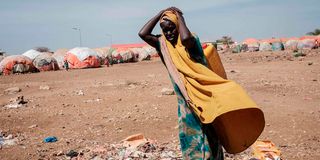Push for NGOs, diaspora to help prevent another famine in Somalia

A woman carries a water container at an IDP camp in Baidoa, Somalia. The country is running out of time to prevent the current severe drought from turning into a famine situation that hit the country hard between 2011 and 2012.
Somalia is running out of time to prevent the current severe drought from turning into a famine situation that hit the country hard between 2011 and 2012.
Granted, neighbouring countries Kenya, Ethiopia and Djibouti are experiencing similar conditions after long rains failed for four consecutive seasons, Somalia is particularly vulnerable because of the insecurity blocking humanitarian aid from reaching certain areas, and the government’s lack of capacity to mitigate impacts of drought before it descends into large-scale famine.
A report by the Heritage Institute for Policy Studies released on October 21, is calling upon the international community to help Somalia escape imminent famine, especially in the southern regions of Bay and Gedo regions, as close to 8 million people are estimated to be food insecure due to poor crop productions and loss of livestock.
According to reports by the United Nations High Commissioner for Refugees, over one million people have been displaced in search of water, food, and other necessities of life since large parts of central and southern regions of Somalia have reached a dangerous level of humanitarian crisis. Several hundred have already died.
Heritage Institute has come up with nine recommendations for short and long-term actions to prevent Somalia from experiencing a repeat of the 2011-2012 famine and a narrow escape between 2016 and 2017.
Among the short-term recommendation is for the government of President Hassan Sheikh Mohamud to mobilise local and diaspora resources to create community engagement, seek financial assistance for food and nutrition purchases to prevent famine, and keep people in their localities.
Unavoidable impacts
Non-governmental organisations should come in in a big way to help to fill gaps in providing emergency services and strengthening local survival capacity, especially in situations where government institutions are weak or absent.
And that international aid and regional cooperation are also crucial in supporting the efforts of states, local authorities and communities that have a pivotal role to play in providing aid and have contributed generously in the past.
Among the long-term recommendations, the government is urged to improve its response capacity, including security situations to facilitate emergency aid delivery; provide communities with the information to plan and prepare for possible climatic shocks that are becoming more frequent and intense.
Community-driven approach
Third is formulating a community-driven approach, consistent with local knowledge and traditions in order to adapt to unavoidable impacts, if and when droughts strike; the government, despite limited resources, should give priority to response mechanisms as drought occurrences are expected to intensify in the coming years.
The government should also conduct thorough research on how people responded to disruptive weather events in the past and whether that can teach people how to be resilient in the future.
This is the third time in 10 years that Somalia has faced the risk of famine. However, the famine in 2010-2011 was the worst in the 21st century, claiming the lives of more than 250,000 people, half of them children.
Why Somalia is vulnerable
The report explains why Somalia is vulnerable this time despite neighbouring countries Djibouti, Ethiopia, and Kenya sharing similar environmental conditions. The report says that Somalia is among the most vulnerable countries to climate change for four reasons.
First, Somalia has been dysfunctional for the better part of the past three decades. Therefore, there is a lack of institutional capacity to mitigate the impacts of climate change before it descends into a large-scale famine.
Second, the lack of security severely restricts the delivery of aid supplies in many areas. Third, environmental degradation such as deforestation is proceeding at an alarming rate, which makes the environment highly susceptible to droughts and floods. Finally, as per the current drought, Somalia’s political turmoil in 2020/2021and the delay in installing a substantive government contributed to the current humanitarian crises.
Droughts and floods
Other observations in the report are that Somalia has long coasts on both the Gulf of Aden and the Indian Ocean, and relatively flat topography with an arid or semi-arid climate, making it prone to recurrent droughts and floods with increasing frequency.
Second, droughts that might have occurred once in 10 years or longer now happen more frequently and with greater intensity due to climate change. Third, weak institutional capacity and the acute lack of security form a toxic combination that severely limits the government’s ability to respond in order to prevent droughts from becoming deadly famine.





